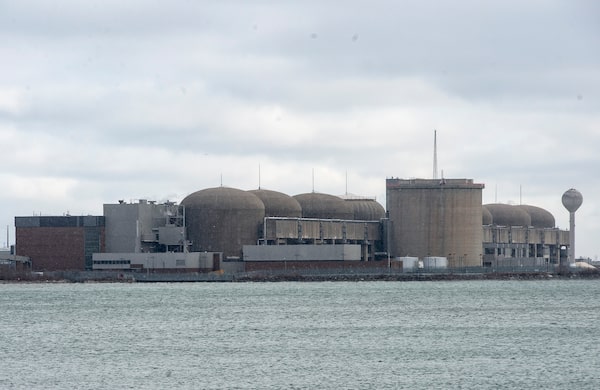
The Pickering Nuclear Generating Station in Pickering, Ont., on Jan. 12, 2020. Ontario Power Generation is moving ahead with a plan to extend the life of the aging Pickering Nuclear Generating Station by decades, as the province tries to secure more electricity supply in the face of increasing demand.Frank Gunn/The Canadian Press
Ontario has rewritten the rules for its multibillion-dollar green bond program and will now for the first time be able to use the proceeds for nuclear-power projects, the latest in a series of pro-nuclear moves made by the Progressive Conservative government.
The Ontario Financing Authority, which issues the province’s bonds, unveiled a new framework on Thursday for green bonds, which Ontario offers when it borrows money to finance capital projects that advance environmental goals.
While the program previously funded a range of infrastructure, it specifically excluded nuclear power. The new framework now includes a provision for “the deployment of nuclear energy to generate electricity and/or heat.”
“I think this is a big step forward,” Ontario Finance Minister Peter Bethlenfalvy said in an interview. “You can’t get to net-zero without nuclear.”
The province has just pledged several large, and costly, expansions of nuclear power as it seeks to expand its electricity grid to meet future demand. This week, it announced the refurbishment of four 40-year-old reactors at Ontario Power Generation’s aging Pickering power station east of Toronto. That project is expected to take more than a decade and cost billions, although the government released no total cost estimate and a feasibility study is not being released to the public.
Ontario already generates more than half its electricity by splitting atoms. While nuclear power plants operate almost free of greenhouse-gas emissions, unlike natural gas or coal, some environmentalists still criticize nuclear power for its high costs, its safety and security risks and the radioactive waste it produces.
The change made on Thursday is not the first time a debt issuer has tested whether the global market for so-called green bonds is willing to embrace nuclear power. Privately held Bruce Power, which operates the province’s largest nuclear power plant, on the shores of Lake Huron, in Tiverton, Ont., issued what was billed as the world’s first nuclear green bond back in 2021, as it sought financing for a massive refurbishment project. Provincially owned Ontario Power Generation has also recently issued a nuclear green bond.
The federal government moved to include nuclear in its green bond program late last year, after objections from the nuclear industry when Ottawa initially failed to include the sector. The European Union has made similar changes, and is being challenged over them in court by the environmental group Greenpeace.
Ontario, which is among the largest sub-sovereign debt issuers in the world, has issued green bonds for a decade. It is the largest issuer of these bonds in Canadian dollars, outstripping the federal government and all other provinces combined, at $16.5-billion. It is expected to issue its first green bonds under the new regime before March 31.
Jonathan Hackett, the managing director and head of sustainable finance at Bank of Montreal, said the market for green bonds has already shown it accepts nuclear as a key part of the solution to climate change.
“People had felt a bit uncertain about whether or not there would be acceptance that including nuclear in these issuances was attractive to investors,” Mr. Hackett said. “And I think we have seen very clear signals that the answer is yes.”
He said a scarcity of green bonds, amid increasing demand from pension funds and other institutional investors, means they are attractive on the secondary market. This allows Ontario to pay generally lower interest rates on green bonds than it does on general government debt, Mr. Hackett said – a premium sometimes called a “greenium.”
Keith Stewart, a senior energy strategist with Greenpeace Canada, said nuclear power should not be considered green enough for green bonds, the way renewable solar and wind power are. He noted that there is still no permanent solution for the radioactive waste it produces.
“If you are getting some kind of a bonus for being green, you should have really high standards for that,” he said.
Chris Keefer, an emergency room doctor who heads Canadians for Nuclear Energy, an advocacy group that has lobbied for the green bond changes, said the move is long overdue.
“There’s been this huge swing back toward nuclear,” he said. “There’s enough momentum now.”